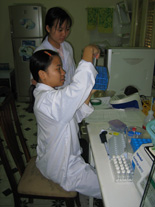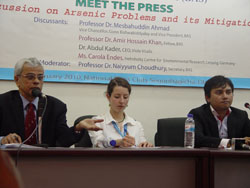Our bacterial bioreporters have been successfully validated in a large-scale environmental study performed in Vietnam. A total of 194 groundwater samples were collected in the Red River and Mekong River Delta regions of Vietnam and analysed both by atomic absorption spectroscopy (AAS) and by the arsenic bioreporter test.
The bacterial cells performed well at and above arsenic concentrations in groundwater of 7 µg/L, with an almost linearly proportional increase of the bioluminescence signal between 10 and 100µg As/L.
Comparisons between AAS and arsenic bioreporter determinations gave an overall average of 8% false negative and 2.4% false positive identifications for the bioreporter prediction at arsenic concentrations of 10µg/L, which is far better than the performance of chemical field test kits.
For more information, read:
Trang et al. (2005) Bacterial bioassay for rapid and accurate analysis of arsenic in highly variable groundwater samples. Environ. Sci. Technol. 39: 7625-7630.
Siegfried, K., C. Endes, et al. (2012). Field testing of arsenic in groundwater samples of bangladesh using a test kit based on lyophilized bioreporter bacteria. Environ. Sci. Technol. 46(6): 3281-3287.


